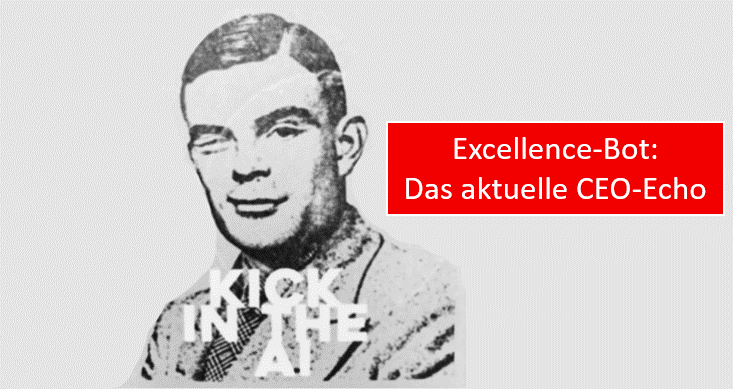The digital media response to all DAX and MDAX managers - here is the public ranking.
About the CEO Echo
.companion specializes in digital evaluation and organization of communication and marketing. We continuously examine and interpret the digital media response to all DAX and MDAX CEOs. Measurements are made with the market-leading media monitoring tool Talkwalker. All publicly accessible digital media content is searched globally, in English and German, social and web, private and editorial (before the paywall). Analysis and interpretation of the data is handled by an in-house key figure bot, which processes the data monthly and generates this text fully automatically. The key figure bot also generates individual evaluations on request.
Order your individual evaluation here!
CEO echo in March 2020: 2% more mentions of DAX and MDAX managers
In March, the .companion metrics bot found 2% more CEO mentions than the average of recent months. Overall, 79% of CEO Echo was generated by online editorial content, with social media accounting for 21%. Overall, CEO Echo content activated its readers 18% more frequently in March than previously.
59% of mentions of all DAX/MDAX CEOs took place in the context of financial news. In contrast, 41% had a content context more suitable for setting themes and influencing reputations. Overall, the digital media response to the top appointees had a weak coloration, with similar amounts of positive and negative tone.
Footprint: Herbert Diess (Volkswagen) dominates 17% of total CEO echo
What share of the total CEO footprint does a DAX/MDAX CEO have, whether voluntarily or involuntarily? The CEO footprint answers this question.
In March, Herbert Diess (Volkswagen) received the most media attention. He had a Share of Voice of 17% and thus the largest footprint of all board members. In second and third place this month were Carsten Spohr (Lufthansa) with 13% and Joe Kaeser (Siemens) with 8% share of all mentions. This echo took place to 57% not in the financial context and was suitable thus above average for setting topics and contents. 74% of the Volkswagen CEO's echo came from editorial media, 26% from social media. Content that mentioned Diess generated 6 interactions per mention. This corresponds to a rather average reader activation (16th place among all CEOs). In total, the content mentions of Herbert Diess showed a rather average coloring with a tonality that was more often negative than positive. A corresponding image effect can be assumed.
Communication Excellence: Munich Re's Dr. Joachim Wenning sets content best in editorial departments
Good media relations aims to set topics and build reputation. This is best achieved through placement in articles that are not financial news and are published by editorial media. Our key performance indicator bot shows which DAX/MDAX companies succeed in this with the Communication Excellence ranking.
In first place last month was Dr. Joachim Wenning (Munich Re). Before the paywall, 59% of his digital echo had a content context beyond business figures. His content showed 66 interactions per mention, representing very strong reader activation. In addition, the texts had a strong tonality with significantly more positive than negative colorations. As a result, the response to Munich Re's chief executive scored 3.1 points. In second and third place in Communication Excellence are Christian Klein (SAP) with 2.9 points and Rolf Buch (Vonovia) with 2.4 points.
Social Excellence: Tim Höttges (Telekom) with the best social media echo
"Social is not an end in itself. But if you want to have an impact on opinion leaders outside editorial departments (influencers) or on consumers and digital elites who are not easily reached by the mass media, you have to be mentioned as frequently and as effectively as possible in social media. The Social Excellence Index answers whether this is successful. Our metrics bot interprets the proportion of mentions in social media, the strength of reader activation, and their emotional color.
In March, Tim Höttges (Telekom) leads the rankings with 3.9 points. Tim Höttges ' response was 57% "social", his reader activation very strong with 26 reactions to one mention; the emotional coloring of his mentions was 7% positive. He was thus well ahead of runner-up Christian Klein (SAP) with 2.0 points and Oliver Bäte (Allianz) in third place with 1.7 points.
Responsibility Excellence: Christian Klein (SAP) with best response on social responsibility
The .companion indicator bot also determines whether DAX/MDAX CEOs appear in the digital media echo as leaders in the context of the UN's sustainable development goals, i.e., in the context of social responsibility or climate and environmental protection, for example. Our Responsibility Index shows how well this has been achieved. For it, the KPI bot interprets only the mentions that took place in this topic context.
Last month, Christian Klein (SAP) came in first in the responsibility rankings. The SAP CEO's response was 20% related to social responsibility topics. Here, his reader activation was 39, which represents a very strong interaction level. The tone was very strong, with significantly more positive sentiment than negative. Overall, Klein's Responsibility Index thus scored 4.1 points. Rolf Buch (Vonovia) followed in second place with 1.5 points, and Hans van Bylen (Henkel) in third place with 1.5 points.
Investor Excellence: Stephan Sturm (Fresenius) with best financial echo
CEO mentions in the context of balance sheet figures offer little scope for setting content-related accents, but are crucial for building investor confidence.
In this environment, the KPI bot determines which CEOs were mentioned and how well, and forms an index for investor communication.
As the top communicator for investors, the .companion metrics bot determined Fresenius in March: CEO Stephan Sturm scored the best with 3.7. 84% of his mentions were related to the financial environment, which is 1.2 times the average. His reader activation was very strong at 15.9, and the tone was very weak, with significantly more positive sentiment than negative. He is followed in second and third place by Hans van Bylen (Henkel) with 2.2 and Jürg Oleas (GEA) with 2.1 points.
